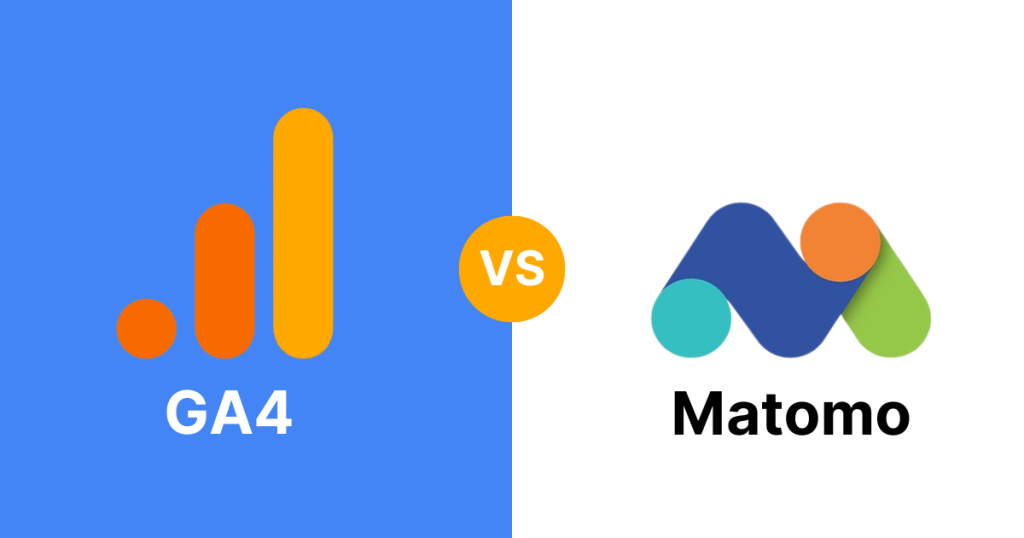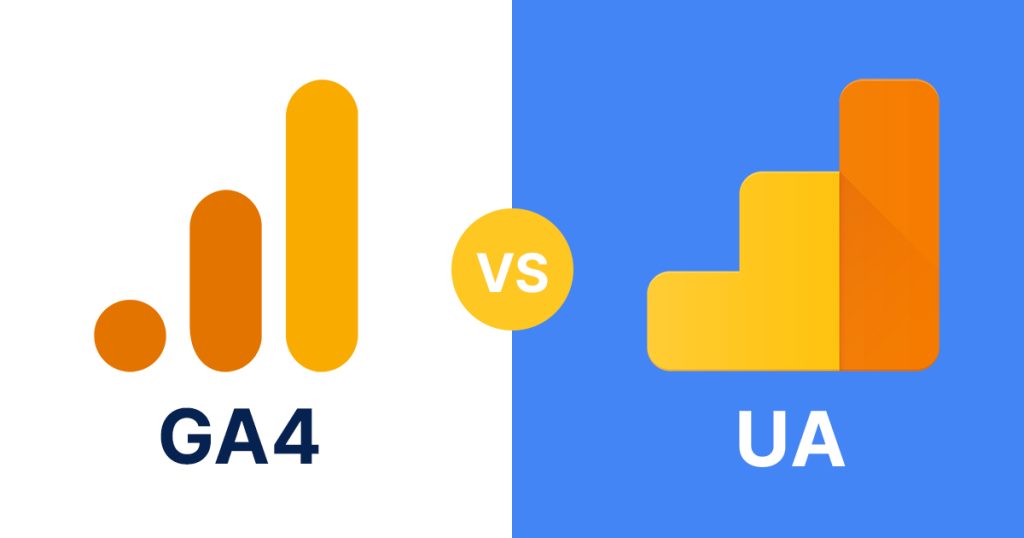In these times, where almost everything is online, it’s important to understand how people interact with your website. Web analytics tools help us see what’s working and what’s not on our websites, guiding us to make better decisions to improve and grow our online presence.
Recently, there’s been a big change in the world of web analytics. Google, which offers one of the most popular analytics tools, made a switch from what we knew as Universal Analytics to a new version called Google Analytics 4. This change has sparked a lot of discussions and has led many to explore other options, one of which is Matomo, a tool that was once known as Piwik.
Both GA4 and Matomo offer powerful features to understand website traffic and user behavior, but they do so in different ways. With this comparison, we aim to look into these differences, helping you figure out which tool might be the best fit for your needs. Whether you’re a small business owner, a blogger, or someone in charge of a large company’s website, choosing the right analytics tool is a step toward achieving your online goals.
If you need help using GA4 or Matomo, our team is here for you. We know how to make these tools work best for your website. For expert help contact us.
Background GA4 vs Matomo
GA4
Google Analytics has been around for a long time, helping website owners understand who’s visiting their sites and what they’re doing. Over the years, Google has made many updates to make its analytics tool even better.
The latest version, Google Analytics 4 (GA4), is a big change from the earlier versions. It’s designed to give a more complete picture of how users interact with websites and apps.
One of the cool things about this tool is how it tracks users across different devices. This means you can see if someone visits your site from their phone and then from their laptop. It also uses machine learning to fill in the gaps where data might be missing, helping you understand your visitors better.
Plus, it’s set up to handle the privacy laws and changes to cookies that are happening on the internet, making it a future-proof choice.
Matomo (Piwik)
Matomo, which you might have heard called Piwik before, is another tool for understanding website traffic, but with a big focus on privacy. It started out as an open-source project, which means anyone can see and improve the code. A few years ago, Piwik got a new name and became Matomo.
What makes Matomo stand out is that it gives website owners full control over their data. Unlike some other tools your data isn’t shared with anyone else (like big advertising companies). It’s a great option for businesses and individuals who care a lot about privacy.
It also offers features like heatmaps, session recordings, and A/B testing, which are really useful for improving websites. Plus, it’s flexible. You can host it on your own server or use Matomo’s cloud service.
User Interface and Usability
When it comes to figuring out how to use GA4 and Matomo, both have their own style and features, but they’re a bit different from each other.
GA4 has a modern look with lots of charts and graphs that make it easy to see what’s happening on your site. It’s pretty different from the older versions of Google Analytics, so if you’re used to those, you’ll need some time to get the hang of GA4.
The layout is designed to focus on user journeys, showing how visitors move through your site and what actions they take. While it’s powerful, some users find it a bit tricky at first because there are so many options and data points to explore.
Matomo has a straightforward and intuitive interface that many users find easy to navigate from the start. It’s laid out in a way that makes sense if you’re not a data expert, with clear menus and reports.
It’s great for people who want to jump in and start analyzing their site’s traffic. You won’t have to spend a lot of time learning how to use it before you can start seeing useful information about your website. Plus, it allows for quite a bit of customization, letting you customize the dashboard to show exactly what you’re most interested in.
Both platforms offer customization options for dashboards and reports. In GA4, you can create custom reports and modify the dashboard to focus on the metrics that matter most to you. Matomo also offers flexible dashboard customization, allowing you to drag and drop widgets and create a view that suits your needs.
Feature
- Interface
- Learning Curve
- Customization
- Ease of Use
GA4
- Modern
- Steeper
- High
- Requires adaptation
Matomo
- Intuitive
- Easier
- High
- Simple from the start
Data Tracking and Privacy
When it comes to understanding how people use your website, both GA4 and Matomo track this information, but they do it a bit differently.
GA4 uses cookies and event-based tracking. This means it can see what people do on your site, like which pages they visit or what buttons they click, by placing small files called cookies on visitors’ devices.
It’s designed to follow the rules of privacy laws like GDPR, which protect people’s data in Europe. It lets users opt-out of tracking and makes sure data is collected in a way that respects privacy.
Matomo also tracks what users do on a site, but it puts a big focus on privacy and data ownership. It uses cookies too, but it allows you to choose not to use cookies at all, making it even more privacy-friendly.
One of the standout features of this tool is that it gives you full control over your data. Unlike other platforms where the data might be used by the company providing the service you own all the information collected.
This is a big deal for businesses that want to make sure their visitors’ data is private and secure. Matomo also makes it easy to follow GDPR and other privacy regulations by offering features like automatic anonymization of visitor data.
Feature
- Tracking
- Privacy
- Data Ownership
- Privacy Features
GA4
- Cookies, events
- GDPR compliant
- Google-owned
- Opt-out, anonymization
Matomo
- Optional cookies, events
- Strong privacy, GDPR compliant
- User-owned
- No-cookie option, full data control
Integration and Extensibility
Both GA4 and Matomo can work together with other tools and platforms to give you a better look at your website’s data. Here’s how they stack up when it comes to working with other software.
GA4 is really good at integrating with other Google products, like Google Ads and Google Search Console, which can help you see how your ads and search rankings are doing. It also works well with popular Content Management Systems (CMS) like WordPress and eCommerce platforms such as Shopify.
For those who need something special, GA4 offers APIs (Application Programming Interfaces) that developers can use to build custom integrations. This means if you need GA4 to do something unique for your website, a developer can probably make it happen.
Matomo is also flexible when it comes to integrating with other platforms. It supports popular CMS platforms like WordPress and Drupal, and eCommerce tools including WooCommerce and Magento.
This tool stands out because it’s open-source, so it has a big community of users and developers who create plugins and extensions to add new features. Matomo’s APIs are available for those who need custom solutions, making it possible to tailor the platform to fit exactly what your website needs.
Feature
- Google Integration
- CMS Support
- eCommerce Support
- Custom APIs
- Extensions
GA4
- Yes
- WordPress, etc.
- Shopify, etc.
- Available
- Limited
Matomo
- No
- WordPress, Drupal
- WooCommerce, Magento
- Available
- Many
Analytics Features
When it comes to figuring out how people use your website, GA4 and Matomo offer a bunch of cool features. Let’s take a look at some of the key features like real-time analytics, tracking user journeys, keeping an eye on conversions, and monitoring specific actions with custom event tracking.
GA4 is all about giving you a detailed picture of how users interact with your site. It has real-time analytics so you can see what’s happening on your site as it happens. User journey tracking in GA4 is pretty advanced, letting you follow a visitor’s path through your site from start to finish.
Conversion tracking is also a big deal in GA4, helping you understand which actions (like sign-ups or purchases) are working well. Plus, custom event tracking lets you keep tabs on specific actions users take, tailored to what’s important for your site.
GA4 has some unique features too, like predictive analytics, which uses machine learning to guess future actions users might take, and cross-platform tracking, making it easy to see how users move between your website and app.
Matomo offers similar features but with a strong emphasis on privacy. It has real-time analytics as well, so you can watch live as people visit and move around your site. User journey tracking in Matomo helps you understand the visitor experience, and conversion tracking lets you see how well your site converts visitors into action-takers.
Custom event tracking is also available, allowing you to monitor specific activities that matter to you.
One of the standout features of Matomo is its privacy-first approach, ensuring that user data is handled respectfully and in compliance with global privacy laws. It also offers heatmaps and session recordings, giving you a visual and interactive way to see what users do on your site.
Feature
- Real-Time Analytics
- User Journey Tracking
- Conversion Tracking
- Custom Event Tracking
- Unique Features
GA4
- Yes
- Advanced, cross-platform
- Yes
- Highly customizable
- Predictive analytics, cross-platform tracking
Matomo
- Yes
- Privacy-focused
- Yes
- Customizable, privacy-conscious
- Heatmaps, session recordings, privacy-first approach
Reports and Insights
Both GA4 and Matomo give you different kinds of reports to help you understand your website better. Let’s look at what each platform offers and how they use smart technology to give you insights and predictions.
User Engagement: GA4 reports focus a lot on how users interact with your site, like how long they stay and what they do.
Demographics: You can see information about who’s visiting your site, including their age, gender, and interests.
Traffic Sources: Find out where your visitors are coming from, whether it’s search engines, social media, or direct visits.
Conversions: GA4 tracks the actions you care about, like form submissions or purchases, and shows you how often they happen.
GA4 uses AI and machine learning to make some smart guesses about your data. For example, it can predict which users are likely to buy something or leave your site. This helps you focus on keeping your visitors happy and engaged.
Real-Time Data: See what’s happening on your site at any moment with live updates.
Visitor Behavior: Get detailed reports on how each visitor uses your site, including the pages they visit and the actions they take.
Ecommerce Analytics: If you sell products online, Matomo can track sales, product views, and shopping cart activities.
Goals and Conversions: Just like GA4, Matomo lets you track conversions but with a strong focus on privacy.
Matomo doesn’t rely as much on AI for its insights. Instead, it offers comprehensive reports that give you a clear picture of your website’s performance without making too many assumptions. This approach puts you in control, allowing you to interpret the data in a way that makes sense for your business.
Feature
Reports
- AI Insights
- Privacy
GA4
- Engagement, demographics, traffic, conversions
- Predictive analytics
- Automated insights
Matomo
- Real-time, behavior, ecommerce, conversions
- No AI predictions
- Privacy-focused reports
Pricing and Support
When choosing between Google Analytics 4 (GA4) and Matomo for your website’s analytics, understanding the pricing and the kind of support you can expect is crucial. Here’s a simple breakdown to help you navigate your options.
GA4
Pricing: GA4 is free to use for its basic version, which is sufficient for many small to medium-sized businesses. However, for larger enterprises or those requiring advanced features, Google offers Analytics 360.
The cost of Analytics 360 can vary significantly depending on your needs, often starting at several thousand dollars per month. This premium version includes additional data processing power, advanced analysis, and support options.
Support: The free version of GA4 relies primarily on community forums and online documentation for support. You can also get expert help from us – Goodish agency.
If you’re using Analytics 360, you get access to dedicated support from Google, which includes technical support and account management services.
Matomo
Pricing: Matomo offers a unique proposition with its dual options. You can use the open-source version of Matomo for free if you’re willing to host it on your server. This requires some technical know-how but allows for significant customization and data control.
For a hosted solution, Matomo Cloud offers a straightforward pricing model based on monthly page views, starting at a price point accessible for small businesses and scaling up based on your needs.
Support: For the open-source version, support is community-driven, with an active forum and extensive documentation available. Paying customers of Matomo Cloud receive direct support via email, and higher-tier plans include priority support.
The responsiveness and quality of support have generally received positive feedback from users, with many appreciating the personal touch and expertise provided by the Matomo team.
Feature
- Basic
- Premium
- Support
GA4
- Free
- $$$+
- Forums & Docs
Matomo
- Free / Paid Cloud
- $+
- Forums & Direct (Paid)
Pros and Cons
When choosing between Google Analytics 4 (GA4) and Matomo, there are several key factors to consider, including the learning curve and data privacy. Here’s a look at these aspects for both platforms.
GA4
Pros
Integration with Google Products: GA4 works well with other Google services, which can be a huge plus for businesses already using Google’s ecosystem.
Advanced Tracking Capabilities: Offers sophisticated user tracking and analytics features powered by Google’s machine learning.
Cons
Steep Learning Curve: It can be complex to navigate for beginners or non-technical users. It has advanced features that require some learning.
Data Privacy Concerns: Being a Google product, there are concerns about how data is used and shared, especially for businesses in areas with strict privacy laws. Users don’t own their data outright, which might be a deal-breaker for some.
Matomo
Pros
Data Ownership and Privacy: Matomo puts a strong emphasis on user privacy and data ownership, making it an attractive option for businesses sensitive to these issues.
Flexibility: The open-source nature of Matomo allows for extensive customization and self-hosting options, giving users full control over their analytics.
Cons
Setup and Maintenance: For the self-hosted version, setting up and maintaining Matomo can be challenging for those without technical skills or resources.
Learning Curve: While generally considered more straightforward than GA4, Matomo still has a learning curve, especially to fully utilize its customization options.
Feature
- Learning
- Privacy
- Setup
GA4
- High
- Lower
- Complex
Matomo
- Moderate
- Higher
- Technical
Conclusion
Choosing the right web analytics tool is important for understanding and improving your online presence. Through this comparison of Google Analytics 4 (GA4) and Matomo, we’ve explored the details of each platform to help you make a decision suited to your needs. Whether you prioritize advanced tracking capabilities, integration with other tools, data privacy, or ownership, both GA4 and Matomo offer unique advantages.
GA4 stands out with its integration with Google’s ecosystem and advanced analytics powered by machine learning, ideal for those looking to use data for predictive knowledge and cross-platform tracking.
On the other hand, Matomo shines with its strong stance on data privacy and full control over analytics data, appealing to those who value ownership and are cautious about sharing information with third parties.
Ultimately, your choice between GA4 and Matomo should align with your technical resources, privacy priorities, and the specific analytics needs of your business. Both platforms have their learning curves, but they also offer comprehensive insights that can drive your online strategy forward.
We at Goodish agency are experts in digital marketing and we can help you to utilize AI to reduce your costs and boost your performance. Read more about our services.











